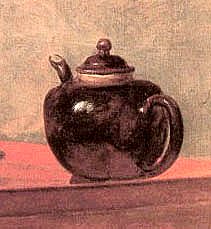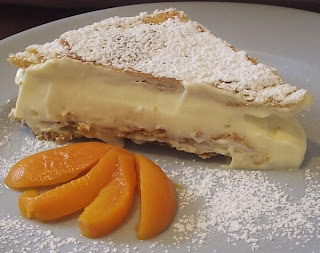
Peau d’Espagne is a combination of flower and spice oils that is used to impregnate leather with scent. To further enhance the exotic smell, civet (cat musk) and grain musk (obtained from the wild deer whose grain [gland] you see here) are added to gum (tragacanth) mucilage which is used to secure two pieces of leather together under pressure. The resulting
Spanish Leather is then used to scent writing paper, ladies gloves & linens—the scent is reputed to last for years. However, the
peau d’Espagne can also be used to add flavor to meat dishes.
In the kitchen, use a drop of oil in a carrier oil, such as olive, poured over a dish at the last minute prior to serving, much as one does orange or rose flower water—the heat of the dish will waft a delightfully exotic aroma. Or it can be added to warm tea or spirits used to plump up dried fruit before its inclusion in a receipt.
To scent one’s body, perhaps, is its best use today …
«This
fragrance lingers on everything it touches like a rugged kiss from a cowboy soaked in campfire smoke and saddle leather sweat. It smells like the sexiest man you've ever seen in your life, taking a hot outdoor bath in a tin tub, smeared with sweet shaving lather and dust, steaming on a cold high-desert morning.»
«More specifically, according to
Havelock Ellis:
“Peau d'Espagne may be mentioned as a highly complex and luxurious perfume, often the favorite scent of sensuous persons, which really owes a large part of its potency to the presence of the crude animal sexual odors of musk and civet. It consists of wash-leather steeped in ottos of neroli, rose, santal, lavender, verbena, bergamot, cloves, and cinnamon, subsequently smeared with civet and musk. It is said by some, probably with a certain degree of truth, that Peau d'Espagne is of all perfumes that which most nearly approaches the odor of a woman's skin; whether it also suggests the odor of leather is not so clear”.»
«1355. Peau d'Espagne, or Spanish Skin, is merely highly-perfumed leather. Take of oil of rose, neroli, and santal, each 1/2 ounce; oil of lavender, verbena, bergamot, each 1/4 ounce; oil of cloves and cinnamon, each 2 drachms; in this dissolve 2 ounces gum benzoin. In this steep good pieces of waste leather for a day or two, and dry it over a line. Prepare a paste by rubbing in a mortar, 1 drachm of civet with 1 drachm of grain musk, and enough gum-tragacanth mucilage to give a proper consistence. The leather is cut up into pieces about 4 inches square; two of these are pasted together with the above paste, placed between 2 pieces of paper, weighted or pressed until dry. It may then be inclosed in silk or satin. It gives off its odor for years; is much used for perfuming paper, envelopes, etc.; for which purpose 1 or 2 pieces of the perfumed leather, kept in the drawer or desk containing the paper, will impart to it a fine and durable perfume.»
Encyclopedia Of Practical Receipts And Processes, by William B. Dick.
Receipt de Cuisine:
Used in
Poulpette à l’Italienne – Italian Meatballs

 Crackling crust another way used to form a rustic tart baked on paper and filled with a jar of very old plum jam I couldn't bear to throw away. I seasoned it with a few grinds of black pepper to cut the cloying taste of the jam. As you can see from the crumbs on the plate, my husband had more than one piece. Pepper with sweets is an old taste, but a very interesting one and very good. The crust was so delicious that I tried it with sweetened cheese, as well. Superb with coffee for breakfast or dessert!
Crackling crust another way used to form a rustic tart baked on paper and filled with a jar of very old plum jam I couldn't bear to throw away. I seasoned it with a few grinds of black pepper to cut the cloying taste of the jam. As you can see from the crumbs on the plate, my husband had more than one piece. Pepper with sweets is an old taste, but a very interesting one and very good. The crust was so delicious that I tried it with sweetened cheese, as well. Superb with coffee for breakfast or dessert!


 Cool, brisk weather means it's time to dig the raifort - horseradish roots to grind and preserve in white wine vinegar. After several weeks, the vinegar makes a wonderful liquid to deglaze fond and to flavor vinaigrette. The root itself flavors soups, sauces and roast meats.
Cool, brisk weather means it's time to dig the raifort - horseradish roots to grind and preserve in white wine vinegar. After several weeks, the vinegar makes a wonderful liquid to deglaze fond and to flavor vinaigrette. The root itself flavors soups, sauces and roast meats. Well, I finally harvested the one apple that has been hanging on my little tree. The tag said just Calville when I planted it early in 2008. This spring the flowers were double and white, not pink as the print suggests. The skin is pale red with a tinge of yellow. Its taste is sweet, slightly strawberry or tart in flavor; its flesh crisp and juicy. Its texture would make great baked apples.
Well, I finally harvested the one apple that has been hanging on my little tree. The tag said just Calville when I planted it early in 2008. This spring the flowers were double and white, not pink as the print suggests. The skin is pale red with a tinge of yellow. Its taste is sweet, slightly strawberry or tart in flavor; its flesh crisp and juicy. Its texture would make great baked apples.  There were several small bumps or ribs on its blossom end. There is only one problem--I asked for a Calville Blanc d'Hiver (1598), not Rouge d'Automne (1670), from the nursery. I shall have to reorder a Calville Blanc.
There were several small bumps or ribs on its blossom end. There is only one problem--I asked for a Calville Blanc d'Hiver (1598), not Rouge d'Automne (1670), from the nursery. I shall have to reorder a Calville Blanc.

















